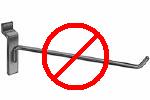Display Hooks Can Cause Blindness or Permanent Brain Injury
10 July 2011 Leave a comment
When I conduct property liability inspections for retail establishments I’m always on the lookout for display hooks with straight ends.
They pose a very real hazard that comes with some VERY SEVERE consequences, including the possibility of:
- DEEP PUNCTURE WOUNDS,
- BLINDNESS,
- BRAIN DAMAGE, or
- DEATH
Straight display hooks truly are “an ‘accident‘ waiting for a place happen” especially when they are located low on a wall or on a display where children and toddlers have access to them. The worst case scenario is when a child stumbles while walking or running towards a display case and falls onto a hook that penetrates through the eye and into the brain.
Typing those words makes my blood run cold; especially because I know it can AND has happened many times in North America and around the globe.
What’s worse, the hazards have been recognized for more than 30 years yet many retailers still use these dangerous hooks – even though there are readily available, safe alternatives (J-Hooks, looped hooks, and hooks that have square plates covering the hook’s point).
Yes, parents have a responsibility to maintain control over their children; however, that is not as easy as it may sound. ANY parent will agree. It’s unreasonable to believe that a parent or caregiver can prevent an incident like this from occurring at all times.
The responsibility truly rests with the property owner – they have a duty to protect their employees, customers, contractors – anyone who steps foot into their store.
What is more troubling to me than the fact that straight hooks are still used today is that it seems to me that straight hooks are used most frequently to display products that are enticing to young children. When straight hooks are used to display toys and other goods that are attractive to children, the probability that a serious incident could occur is greatly increased.
Make a Difference in Your Community:
I extend a challenge to all who read this blog to make a difference. You hold the power to effect change.
Every single time you spot straight hooks displaying products that are within a child’s reach send an email to the store manager asking them to replace the straight hooks with safer hooks. Pull out your digital camera, smart phone, etc (if you have one handy) and take a photo of the hooks. . . this adds impact to the email.
Why send an email and instead of making a phone call or speaking directly to a manager? Because you’ve just created a permanent record of your request. The manager will be more likely to act knowing that you have proof of the request.
Sample e-mail wording:
“I was shopping at your store located at {insert address / location here} on {insert date here} when I came across some straight display hooks that are hazardous to children (see attached photo). {delete previous statement if no photo to attach}
Straight hooks have caused blindness and permanent brain damage to children who have fallen against them. Safer, alternative hooks are available and I’m asking if you would consider replacing all of your straight hooks with a safer alternative.
Please respond to my email so I know that you’ve received it and so you can let me know what your plans are.
I appreciate your time and look forward to hearing back from you.
Truly,
{insert name here}”
Links to online content regarding straight hooks:
These Straight Hooks Have Resulted in Blindness and Brain Damage
Note: I remember reading about a child who died from his/her injuries (over 6 or 7 years ago). If you know of a case where a straight hook caused death, please comment with info that can point me to an article or story about it.
Thank you!
Ian Currie

